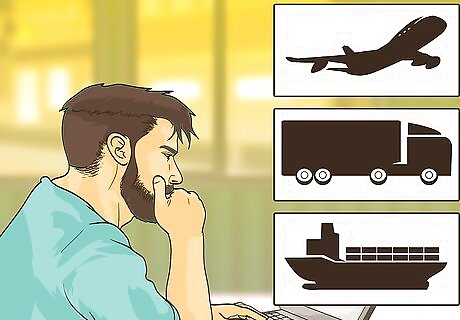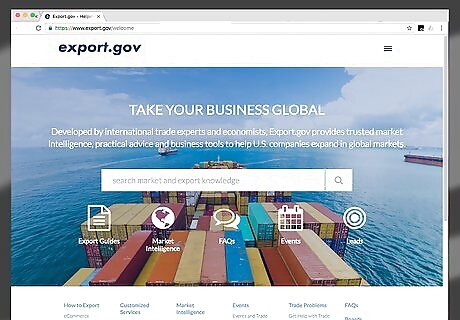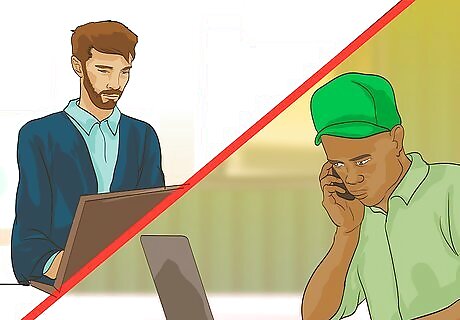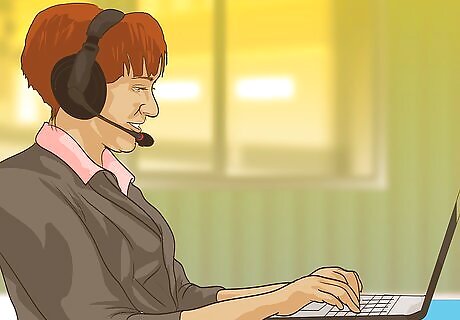
views
X
Research source
To start an export business, you will need to decide which products you will sell, complete the requirements for establishing a business, find funding, and develop channels to sell your goods in other countries.
Planning Your Export Business

Gain an understanding of the export business. In order to get started in exporting, you will need a thorough understanding of the industry and how the actual exportation process works. Research the export business by visiting federal government websites like the U.S. Department of Commerce and Export America. If you already have an idea of which countries you want to export to, you can start learning by figuring out those countries' regulations, tariffs, and duties. It helps to have an understanding of a foreign country or language to start with. Alternately, experience in international trade or shipping helps prepare you for the challenges of running an export business. Further assistance is available from the Small Business Administration (SBA). This government body provides specialized export advice from its Export Assistance Centers. Find one near you by visiting the SBA's website at https://www.sba.gov/managing-business/exporting/us-export-assistance-centers.

Decide what type of export business you will open. Exporters can choose from three main types of business operation. Each one serves a slightly different type of customer and focuses on different aspects of the market. The types are: An export management company (EMC). These businesses assume the task of marketing and selling products overseas. Such a company normally makes money by commission and sells for domestic producers who are unwilling to work overseas themselves. An export merchant is an independent contractor who purchases goods directly from domestic producers and then sells them to other countries. Export trading companies (ETC) seek out specific goods to satisfy their overseas buyers.

Figure out what you will sell. Outline the products you plan to sell including whether you will manufacture them yourself or purchase the goods wholesale. There is no set guide for determining exactly to sell, except for that you will need to beat out both other exporters of that good and domestic producers in the country you are selling to. Your product must be unique, lower-priced, or of a higher quality than competing products to do well in a foreign market. Exported goods typically fall into three categories: Unavailable in a foreign market. These are things that your target country isn't able to produce. For example, Iceland has to import pineapples. Source reputation. These are goods that considered to be of higher quality if they are from certain locations, like French wine or Italian shoes. Lower price. These are goods that can be produced at a lower price in another country than in your target country, like Chinese electronics. In some cases it may be that your export business is an extension of a domestic sales operation. If you get many foreign requests for one of your products, consider expanding to serve that market.

Identify your target market. First, you'll need to identify who exactly you will be selling to. Think about who would be interested in buying your product. This can be consumers, retailers, manufacturers, wholesalers, governments, or another foreign entity. If you're already in business domestically, you should pursue customers in the same industry first. Work with your domestic colleagues to see if they have any contacts overseas and use any connections you can make to your advantage. Try to locate a market in which your business would have a price or efficiency advantage over local alternatives. You can study your chosen market or markets by visiting trade shows, conferences, and missions. These events will allow you to meet prospective agents or partners and also to check in on your competition. Don't bother with hosting a booth, instead just walk around and get a feel for the market. Part of your market identification process should also be to assess the inter-country payment processes and currency differences. In other words, make sure you can safely receive payment from the target country and look out for favorable exchange rates.

Understand your target consumer. Research their needs and gauge their desire for your product. Your market should be relatively easy to identify after you decide what type of products you will sell; however, in some cases, you may need to alter your product offerings to meet their needs. This will take some trial and error, along with a bit of foreign customer interaction either online or on the ground. Try using research to get a clearer view of the following: Your product's applications and marketability in the target country. Your target end-user (who will actually use your products) and their needs. The status of the target country's economy and its citizens' purchasing habits. How exactly you can enter the market (through distributors, wholesalers, retailers, etc.). You should also study the culture and ethics of your target market. This will help you in negotiations and meetings with prospective buyers. Try locating websites or books that will help you with your specific market's culture. There are a number of trade and industry publications that deal with international trade. Study market reports, financial news, and foreign newspapers as well. Anywhere you think you can get a lead or business idea is worth reading.

Maintain compliance with U.S. trade regulations. The United States enforces a large number of important laws regarding international trade. One of the most relevant of these laws, especially for export businesses, is the Foreign Corrupt Practices Act. The bulk of this law is designed to prevent U.S. businesses from engaging in illegal business practices, such as bribery, while doing business with foreign entities. Be sure to study this law and the laws of the target country carefully, as foreign officials may make it unclear what charges are legally required and which are carefully-planted bribes. There are also a number of trade restrictions and embargoes in place with certain countries. These restrict the sale of certain products, either in quantity or entirety, to designated countries as a matter of national security or policy. Check with US Customs before exporting any goods to make sure that yours do not fall under one of these regulations. Information on embargoes, restrictions, limits, and barriers can be found by visiting http://www.export.gov/index.asp.

Write a business plan. Your business plan is an overview of how your business will operate and make money. It includes descriptions of the products that will be sold, your target markets, a marketing plan, industry analysis, competitor analysis, and earnings projections. You'll also need to specify how you plan to fund your business and any partners you will be working with. You will also make decisions about the size of your business. For example, you would need to decide whether it will be home-based with you as the sole employee or if you will need to lease or purchase a work space and hire a staff. Get information from the United States Small Business Administration's (SBA) website about writing a business plan. You can also find other resources that will assist you in starting your business on the SBA website such as licensing and funding information. In your business plan, write out how you plan to make money. That is, if you're adding a commission on top of the price of items you are exporting, how much of a commission will you charge? The commission you charge will depend on your competitors' prices for the products, your own expenses, and your own market research. Many exporters operate on a 10 percent commission. However, if you're producing the products yourself and exporting them, you'll be able to mark them up much more. Just make sure to check your competitors' prices before pricing your own goods. Your marketing plan should encompass how exactly you plan to sell your products in the foreign country or countries. This includes how you will create exposure for your product and target your market, which you should have already identified. To identify this market, think about what type of person would be interested in your product. Consider then this group's ability to pay for your product. Work to identify a specific market niche and a distinct need that your product fills. This will help you identify your target audience more clearly. Then, focus the rest of your marketing plan around that target audience. When deciding which countries to export to, consider starting with one of the 18 countries that enjoy free trade with the United States. A list of these countries can be found at http://www.ustr.gov/.

Estimate your startup costs. Your need for startup costs can range from under $5,000 to well over $1 million, depending upon the type of export business, products sold, foreign market(s) sold to, and other factors. At minimum, you will need an office space (which can be your home), a computer, business phone line, fax machine, and the relevant utilities to service those machines. In addition, you may need money to travel to the places you are selling to for meetings with partners. If you plan to purchase and sell products yourself, you'll also need money to purchase your initial inventory. All of this will factor into your startup costs. It's okay to start small in the beginning. Test the waters first with a few sales in your target country and increase your efforts if you find success. Wait and use the cash flows from your first sales to finance later sales.
Starting Your Business

Register your business and apply for a business license. Contact your state government. In most states, businesses are registered and licensed through the secretary of state's office. You can access information and applications on your state government's website. The exact process for registration and licensing will depend on your state laws and business structure. As an export business, you will also have to register with the US Government at export.gov by taking an export readiness questionnaire. Additional licenses may be required if you are exporting certain products. Check with US Customs or the SBA for more information. Do a preliminary business name search on your state government's website to determine if the name you want to use for your company is available. Decide on the structure for your business. Some business types include: sole proprietor, limited liability partnership, and corporation. Be sure to apply for the appropriate license based on your chosen business structure. Each license has different requirements and fees.

Find funding. The Small Business Association is a good source for funding your export business. The SBA partners with banks to offer guaranteed loan programs to small businesses. They also offer the Export Working Capital Program (EWCP) to provide exporters with money to service large contracts before payment is received for that contract. Alternately, you can work with a partner or use your own savings to fund your export business. The U.S. Export-Import Bank offers special financing programs to small businesses. In addition, the Export-Import Bank has loan programs that are aimed at supporting minority and woman-owned export businesses.

Get insured. When dealing with foreign buyers, you will have a difficult time tracking down buyers who fail to pay for the goods you deliver to them. To remedy this problem, you can purchase export credit insurance, which covers any payments not made by foreign buyers. It generally covers payments not made due to business issues, like bankruptcy, or political issues, such as revolution or government seizure of property. Coverage can be purchased from many commercial insurance providers or the US Export-Import Bank (Ex-Im Bank).

Rent office and storage space. Your business space needs will vary depending on the nature of your business. If you plan to hold product, you will need a warehouse or at least storage space. You can work from home if you don't need a lot of storage space or will not be handling products yourself; however, if you plan to start a larger operation with other employees, you should also seek out office space.
Exporting Products Successfully

Partner with a company or individual who can assist you with exporting your products. Making successful sales abroad will require you to make contacts there, a task which can be difficult for small business owners with no connections. That is why it's best to work with a foreign distributor or another agent or partner that already has a network in your target country. Your foreign contact can either be an agent or a partner. A partner shares in the profits and liabilities of the business, whereas an agent simply works for a defined level of pay. The US government offers the Gold Key Matching Service to help match exporters with overseas partners. For example, you could work a foreign wholesaler/distributor or a retailer to get your product into their market. You can also look out for a foreign sales representative who will sell your products to retailers and wholesalers on your behalf.

Take advantage of technology. When creating an overseas network, the most cost-effective strategy is to make use of the internet. First, work to create a professional-looking website. This site will have to act as the face of your business to many international clients, who will look up your website as a first step prior to doing business with you. Make sure to include a description and pictures of products, contact information, and transaction terms. In addition, include a website in the language of the country to which goods are being exported. To create connections, seek out international trade and export forums, chat boards, and directories. If you find some that are particularly relevant to your product, post on them with an offer and a link to your website.

Organize shipping. One of your major consideration when exporting goods is deciding how to get those goods to your customers. If you are shipping to a relatively close-by country, like Canada or Mexico, you can use land transportation for cost-effective shipping. When shipping further away, however, you have two options: air or maritime shipping. Air shipping is the faster option but can be much more expensive. Maritime shipping is cheaper but much slower, which could lead to long gaps between when the product leaves you and when it arrives (and you get paid for it). Your best move is to work with an international freight forwarder to figure out which option works best for your business. Shipping can either be free on board (FOB) or free alongside (FAS) for the buyer. FOB means that the seller is responsible for delivering the goods to the buyer at no additional cost to them. FAS means that the seller transports the goods to a ship, where the buyer takes possession of the goods and pays to have them loaded and shipped. Work with a freight forwarder to organize your shipping, storage, and documentation. Freight forwarder contacts can come from personal recommendations or from local listings.

Make deals with buyers. When you've located buyers, you'll want to check out their operations and creditworthiness to ensure that you will be paid for your goods. Run a web search for their business and confirm that they have a reputable website, customer reviews, and/or a good business rating. When making deals with buyers, make sure to transcribe any verbal agreements you make to written agreements. And if you can't effectively communicate with the buyer, hiring a translator is worth the expense to avoid confusion or disagreements. US Embassies in your target country may be able to help you assess a prospective customer's reputation.

Set payment and pricing terms. When pricing your goods for foreign customers, you'll have to decide either to price your goods in dollars or in the target country's currency. Working in dollars simplifies your own accounting and protects your end from currency fluctuations, but can make trade more difficult for foreign customers. Whichever way you decide to set prices, though, make a choice and stick to it. Be aware of foreign exchange (FX) risk if you decide to work in the target country's currency. This is is the risk that you will lose money due to devaluation of the foreign currency against the U.S. dollar. You can manage this risk in several ways, including pricing your sales in the foreign currency in exchange for cash in advance. You also need to set very clear payment terms so that you are not left out to dry as payment for your products is "processing" or "awaiting approval" on your customer's end. Foreign buyers often choose to send payment through letters of credit. You may need to contact your bank to set up the ability to receive this type of payment. Getting a letter of credit from the buyer before shipping goods is more critical to the seller than the buyer. Trying to collect debts in a foreign country is difficult, time-consuming, and expensive. For small items, credit cards and bank transfers before shipping should be the rule. To simplify payment, you can use a large, international bank with a presence in both your country and the target country.

File the proper documentation. When you get started exporting your goods, you will have to deal with a large amount of government controls and paperwork, both on the US end and in the target country. The relevant government authority should provide guidance on filling out these forms; however, your overseas partners and/or any shipping partners you have should also be able to help you out if you get confused, especially if they are very experienced in that country.

Fill your first orders. When you've find an overseas buyer, it's time to pack and ship your goods. Start by creating a pro forma invoice, which is a quote for the price of your products, along with the costs of insuring and shipping them (if this is charged to the importer). Work out payment with your importer and organize your shipping and insurance with the relevant companies. Make sure that payment (or a guarantee of payment like a letter of credit) arrives before shipment of goods. When it does, pack up your goods and have them shipped. Make sure to save any shipping documentation you receive. Wait for confirmation from your buyer that your goods have arrived. You've just made your first export sale! After your items ship, you will receive a bill of lading. This document guarantees that your items arrived at the destination in good shape.




















Comments
0 comment